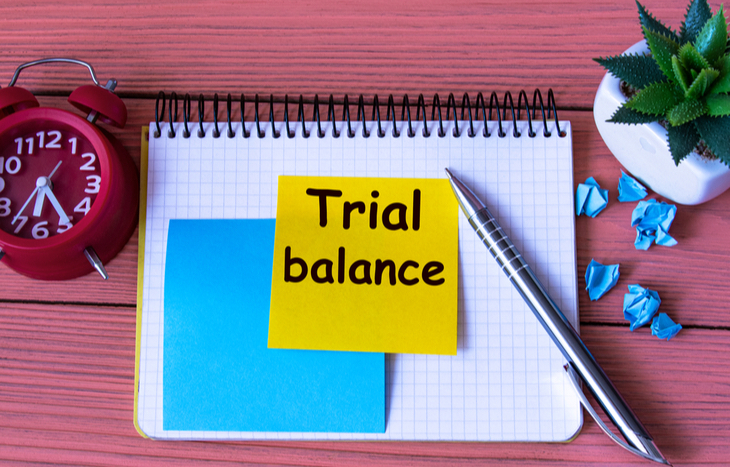What is a Trial Balance?
Closing the books on an accounting period is a lengthy and complex process. No matter how complex, it needs to start somewhere. For every company, big or small, it starts with a trial balance. This is an accounting worksheet that displays the sum of all credit and debit balances at the end of an accounting period and/or fiscal year before closing entries. For the trial balance to be correct, debit and credits must be equal.
The trial balance is a handy accounting tool. And companies, accountants and auditors alike all use it to better-understand the business’ financial standing. If debits and credits don’t add up, it means there’s an error somewhere. Even when they do add up perfectly, there’s significant information worth gleaning from this worksheet.
Here’s a look at what a trial balance is, its role in closing the books and how it’s used to ensure financial accuracy and transparency for filings.

The First Step in Closing the Books
Preparing a trial balance is the first step in closing the books on a financial accounting period. An accountant lists all debit and credit account totals on this worksheet. This ensures a complete accounting of all accounts within the ledger. Then, they total the sum of all accounts on each side. The result should be a perfect balance between the two.
The trial balance is the pinnacle of the double-entry accounting standard. It serves as the first sign of accuracy (or inaccuracy) when the time comes to close the books on an accounting period. If the company meets double-entry accounting standards, debits will equal credits. But if they don’t, it means there’s a debit or credit without a matching transaction somewhere on the opposite side of the worksheet.
If the trial balance reflects equal sums for debits and credits, the company can move on to the next phase: adjusting journal entries. If there’s a mistake, companies need to have auditing controls in place to investigate the nature of the misattribution. In fact, the company needs to identify the entries needed to balance debits and credits.
What Happens if Debits and Credits Aren’t Equal?
There are three possibilities when the amounts on a trial balance don’t add up:
- The trial balance wasn’t prepared correctly;
- Journal entries weren’t transferred to the ledger accounts correctly; or
- There’s an omission or misappropriation of debits or credits.
Regardless of which reason is valid, they all signal a problem. After re-checking the trial balance, companies need to rely on auditing controls to work backward to uncover the source of the problem.
Most often, the problem is a clerical error. Moving a decimal point or swapping two numbers in a balance can quickly throw the trial balance off. This is why many modern accounting platforms automatically record double entry—to prevent user error. Even still, it can happen. If entry error isn’t to blame, start looking at the sum of the discrepancy, to see if it was misattributed somewhere else.
Until a company fixes its trial balance sheet, it can’t proceed in closing its books. This is why many companies have ongoing auditing practices: to prevent a delay in closing the books on a financial period.
How is the Trial Balance Used in Accounting?
The primary purpose of the trial balance is as a reasonableness test of the company’s books. Not only does it alert accountants to a problem if debits and credits don’t add up, CPAs familiar with the books can often eyeball accounts to see potential discrepancies. For example, if the depreciation amount remains the same from one accounting period to the next, it’ll appear the same on the trial balance, alerting the accountant to a mistake.
Auditors also use the trial balance to determine where to begin an audit, or when selecting an account for a cursory audit. They’ll frequently look for oddities that attribute to certain accounts. Auditors may also choose to investigate certain accounts due to their relative representation on the balance sheet. For example, if a company has a high depreciation figure, yet comparatively few capital assets.
One drawback of the trial balance is that it doesn’t account for bookkeeping errors. That means debits and credits will still add up even if they’re made to the wrong accounts. This is why it’s often important to review each line item on the trial balance.
Unadjusted vs. Adjusted Trial Balance
When closing the books, companies prepare two trial balances: unadjusted (preliminary) and adjusted. The first trial balance is unadjusted—also called preliminary—because the company makes no period adjustments when compiling debit and credit accounts and figures. Then, after preparing adjusting journal entries, the company generates its adjusted trial balance. Both trial balances serve as checkpoints, to ensure companies aren’t moving forward in closing their books with inaccurate or unbalanced financial information.
The Most Important T-Sheet
When it comes to accurate financial reporting, the trial balance is perhaps the most important T-sheet a CPA will look at. If debits and credits aren’t equivalent, it’s the sign of a problem in one of the business’ ledger accounts.
To learn more about financial reporting and various accounting practices, sign up for the Investment U e-letter below. We will help you expand your financial literacy and give you expert investment insights in the process!
While modern accounting software makes trial balances relatively obsolete in practice, they’re nevertheless an important tool in looking at the broad standing of a business’ accounts before it closes the books on a period. Catching a simple error via the trial balance can help avoid major headaches and amended filings in the future.





